
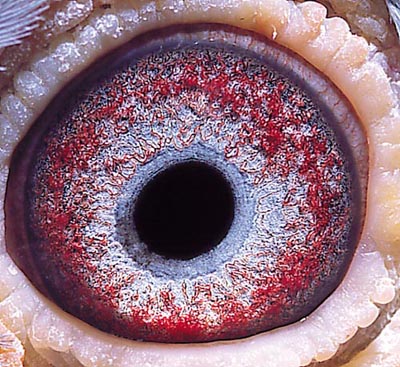


Introduction
|
Bring pigeons eyes up as a topic for discussion between a group of pigeon fanciers and you'll be amazed at the different responses you get. Some will jump right into the pros and cons of the various "Eye Sign" theories as a performance indicator while others will point to the genetically different eye colors and how to breed for color to achieve the show standards required for the many different breed types. Both of these topics are highly debated and for some reason very few will agree on either subject. Why is there such disagreement? To me the answer is simple. There isn't enough scientific research conducted on "Eye Sign" to come to their final conclusions nor is there enough factual information published on "Genetics" to explain eye colors. The eye sign enthusiasts have done an excellent job publishing books, pamphlets and videos to get the word out but they don't always agree with each others findings. They all admit to there being exceptions to every rule but that's not how science works. In true science there are no exceptions to any rule without clear understandable causes and those causes should be both explainable and demonstrable. Back somewhere around 1947, when I was only six years old, pigeon men here in the U.S. began hearing and reading about the secrets of eye sign. This is not to say that the subject isn't much older because it may very well be. However, it wasn't until after World War II that eye sign took this country’s pigeon enthusiasts by storm. A few self proclaimed experts began publishing their books and gave their demonstrations and presto, the quest for the secrets contained in the eye was on. Naturally flyers of that day, like my Grandfather, began looking into the eyes of their pigeons to discover their bird’s potential as both racers and or breeders. I'm sure, for them, it was a fascinating subject just as it is today. Theories were put forward and terms like the circle of adaptation, circle of correlation, speed lines, distance lines, breeding grooves etc. just to name a few became the topic of discussion at the local gathering places. |
These theories were not limited to pigeon racers only, as other performing breeds such as rollers and highflyers were soon to follow in that same pursuit. Today there are many books and videos to explain the various eye sign theories but until they are scientifically proven or disproved, these theories remain theories. They still require the correct type of research under controlled conditions to be conducted. When that happens the findings that support their claims can be made as proven facts. Until then, Eye Sign will remain today what it has been for years and that is simply personal opinions and or theories. Of the two subjects, "Eye Sign" and "Eye Color Genetics" the genetic side has the only proof of controlled scientific research to back their findings. Now having said all that, let me also make this point very clear. These two subjects are not in competition. They address entirely different issues; however, genetic findings that are accepted as proven facts should play a roll in the eye sign advice given for breeding eye colors. Unfortunately they don't and I'll address that more as we get into it. True there are still unanswered questions in genetics that relate to the more uncommon eye colors but by in large most of the mystery of eye color genetics has been solved and it was solved many years ago. What's needed now, is to get the word out to the everyday fanciers and I am trying to accomplish some of that here. In other words, our subject is going to be based on the " Genetics of eye colors ". I'll leave the topic of "Eye Sign" as a performance indicator for others like my good friend Nigel Cowood. In the sport of racing pigeons, it seems to work very well for him and his video does show what to look for in detail. Therefore, I'll leave it to other enthusiasts like Nigel to ring that bell. |
A discussion of pigeon eye color genetics
|
A discussion of pigeon color genetics, be it for feather color or eye color, simply wouldn't be complete without first recognizing the work of Dr. W.F. Hollander. Dr. Hollander may not have been the first to study these things but he is without doubt the foremost leading expert to have done so. He specialized in poultry, mice and fruit flies but his personal love was pigeons. He was without doubt the world's most knowledgeable person to ever study pigeons and study them he did with a passion. In his book "Origins and Excursions in Pigeon Genetics," Dr. Hollander points out that the most significant genetic differences of eye colors are orange, pearl, and bull. The first two, orange and pearl (sometimes referred to as yellow and white) deal with pigment found in the outer side of the iris, while the third; bull, deals with the pigment found on the iris's inner side. Pigment found on the inner side of the iris is only visible when the outer pigment is missing. So as far as the pigeon's eyes are concerned, only two known pigment types (orange and pearl) are possible on the outer iris and only one pigment type is possible on the inner surface. This inner surface when visible has a dark almost black look similar to the effect seen on cattle thus the name bull eye. Hollander was not the first to study these colors. A number of European students prior to 1930 had already done so. Of these, the most pertinent was a S. J. Bessmertnaja who in Russian demonstrated that when you cross birds that were known to be pure for orange eyed with birds pure for pearl, only orange eyed F1 youngsters were produced. He went on to demonstrate that when you crossed one of the orange eyed F1's back to a pearl that both colors, orange or pearl could result. He did this using only ten such crosses. He concluded from his work that pearl was a simple recessive gene and symbolized it tr. If you're a student of genetics, you will soon learn that when two genetic factors are alleles (separate possibilities), like orange eye and pearl eye, then one is going to be recessive to the other. In such case, the recessive one will only display when homozygous or pure while the dominant of the two will display in either condition be it heterozygous split for both or homozygous pure for both. Bessmertnaja's crosses did indicate this but the relatively small number of test crosses (10) were not sufficient to rule out other possibilities. So Dr. Hollander along with an associate R. D. Owen conducted more crosses using far more conclusive numbers. From this far greater study with more extensive data, they were able to confirm Bessmertnaja work. In addition, they also discovered that a sort of imitation pearl effect was produced by the sex-linked brown feather color gene on genetically orange eyed birds. In other words, the gene that produces the brown plumage would also produce a pearl iris color that is an intrinsic effect, one not involving the pearl or tr gene. Several years later, Dr. Hollander went on to discover that another imitation pearl effect was also produced by the rare albino and pink-eyed-dilute genes. Lets pause for a moment and review how these two gene alleles are reproduced in a selective breeding program. If you're not up on the fundamentals of reproduction please go back and review the two chapters Sex, Chromosomes and Genes and Cell Reproduction, Mitosis, Meiosis and Crossovers Ok you read it, now lets put it to the test . Get four white buttons and four orange buttons. These will be our stock pile of gene possibilities for eye colors between two breeding adults. In the test we will only need a total of two each per breeder or a total of four for the pair. put two buttons in one hand and two in the other. Let the buttons in one hand represent one bird and the other hand the other bird. Now slightly open each hand and let only one button form each hand fall to the ground. The combination of the two buttons on the floor represent the youngster's genes for eye color. No matter how many times you run the test, the outcome for these different genetic possibilities will be the same as those shown here to the right. Its just a simple matter of probabilities. Using four orange buttons lets begin by pairing together two orange eyed birds.
Homozygous orange x homozygous orange = 100% pure homozygous orange. The end result is orange eyes. Then pair an orange eyed pigeon that is heterozygous for both eye colors with a pure pearl eyed pigeon. Note that there are two possibilities for this type of cross.
Heterozygous orange x homozygous pearl = 50% for both orange and pearl (resulting in orange eyes) and 50% pure homozygous pearl (resulting in pearl eyes). |
Next
pair two orange eyed pigeons where they are both heterozygous for
both orange and pearl. There are four possibilities here and
all but one are in the orange eye color.
Heterozygous
orange x heterozygous pearl = 25% pure homozygous orange (resulting in
orange eyes) Now
lets pair a pure orange with a pure pearl. Homozygous
orange x homozygous pearl = And
lastly lets pair two pure or homozygous pearl birds together. Homozygous
pearl x homozygous pearl =
Did
you notice the possibility for orange eye is greater than the
possibility for pearl; or that all pearl
eyed pigeons are pure for their pearl eyed gene, regardless of what
color their parents
eyes were? I
want you to remember this and remember it well. When you
read eye sign experts who write "yellow x pearl gives you a superior
pearl
eye, while pearl x pearl is a weaker eye" such advice is pure
baloney!!! These
kinds of old wives
tail should alert you to the writer's ignorance on genetic
matters.
There are no genetic differences between pearl eyes based solely upon
how they
were produced. A pearl eyed pigeon
is pearl eyed
whenever a single gene factor for pearl is transmitted from
both
parents
to their offspring. It is simply
immaterial
what other
genetic possibilities being carried by either parent might have been,
as that
material was not what was passed along to the youngster.
The existence or presence of something not transmitted; nor the absence of something not received is of no consequence. It is only that genetic material, which was transmitted that is of any consequence. All pigeons with pearl eyes are pure for the pearl eye trait regardless of what their parents eye color was. For any pigeon to be a pearl eyed bird it had to receive one pearl gene from each parent regardless if those parents were both yellow eyed carrying pearl; or if one was yellow carrying pearl and the other pure for pearl; or even if both were pure pearl eyed pigeons themselves. Pure is pure 100% of the time.
|
|
Orange
and Pearl eyes
Some eyes are much lighter and brighter than others and some have far grater amounts of red color in the iris. Sometime this red is so grate that the orange or pearl can barely be seen. Sometimes orange is referred to as a yellow eye, while pearl is referred to as white or even fish eyed. Why is this? The answer lies in the amount of blood found in the different variations of these two eye colors.
False pearl of brown Yellow eye Dr. Hollander in his book Origins and Excursions in Pigeon Genetics, put it this way. "Orange is the wild-type iris color of Columba livia, and most feral street pigeons and those in farm flocks have this color. Pearl is strictly a domestic type, some breeds such as Tumblers and Barbs never having orange eyes. Microscopic study has shown that the only difference is in the fine pigment granules on the outer surface of the iris: they are yellow in the wild type, and white in the pearl eye.
|
In addition to the granular pigment, the iris is covered in varying degree with a spaghetti-like mass of tiny blood vessels. These give the iris a reddening effect. Anemia will cause paleness. And some breeds have been selected for minimal blood vessel coverage. For example, the American Domestic Flight has a staring white "fish" eye, but basically it is pearl type. So from these two basic pigment colors we can produce eyes that are yellow, orange, fiery red orange, white or fish eyed, pearl and fiery red pearl or any of the many variations in-between. Their differences all being the result of two pigment colors yellow and white (orange and pearl) and the varying amounts of blood present on the surface of the iris.
However,
today we do find
birds with other eye colors such as green violet and even dark brown
but proof
that these are the result of additional iris pigments has not been
demonstrated. They may be new alleles to yellow and pearl or
they may simply be modifiers to them. We need more data to
learn the answers. One
could safely say that any of the flying
breeds which require long grueling endurance would be those of greater
blood circulation. Increased vascular capability or decreased
anemia are signs of endurance potential but are they only
limited to the eye? If they extend to the body as a whole
then yes the eye could be a good indicator of grueling performance like
racing. In other words the redder the eyes the greater the
potential is for eye sign features like circle of adaptation, circle of
correlation, speed lines, distance lines and breeding grooves in
addition to the increase in endurance potential due to improved
vascular blood flow. The question remains, does
this increase or lack thereof extend to the body as a whole and how
does it relate to homing navigation, rolling, speed in flight and
breeding skills? I do not have those answers.
Before we leave the subject of pearl eyes; I would like to also point out that Dr.Hollander was of the opinion that the pearl eye color is a very ancient mutation. He believed it was originally found only in cretin breeds from Persia. Granted modern day cross breeding has changed some of these breeds eye colors that he has listed as being found only in pearl. Here is how he defined its origins. "The origin of pearl probably was very ancient. My guess is that it was picked up by fanciers before the tumbling trait, since all Tumblers, Rollers, and Highfliers so far as I know are homozygous for tr-(Some exceptions are known in can readily be explain¬ed by crossing.) Related breeds having only pearl eye are the Nun, Helmet, Jacobin, and Magpie. The Barb possibly had Tumbler far back in its ancestry."
"Pearl
is also common in breeds not closely related to
Tumblers.
Show Homers and Exhibition Homers are all
pearl-eyed; other Homers often have pearl, but Carriers and Dragoons do
not. Runts, Fantails, and some Continental
varieties of Pouters, Trumpeters, and Archangels often have pearl iris.
" Breeds never showing pearl, so far as I know, are English Carriers, Dragoons, English Pouters, Modenas, Maltese, Florentines, Hungarians, Strassers, Carneaux (except some Whites), Dewlaps, Damascenes, Swifts, Owls, Blondinettes, Frillbacks, German Toys, Lynx, and the Kings. I know little of the eye color of Chinese breeds." "From this breed distribution it seems unlikely that pearl originated in Europe, or even in the Mediterranean region. Persia seems a good bet -- the place we seem to trace many things back to. Back in those ancient times fanciers must have been peering into the mysteries of the eye too, without benefit of magnifying glasses, but they found a pearl."Origins
and excursions in pigeon genetics page
78, Xlll. PEARL EYE (also --
NPA News, March 1964, page 7)
by W.F. Hollander |
Bull
eyes OK;
fine, but which genes can switch off the iris outer surface pigment
production to display a bull eye? Good question and
the answer is
genes that produce Recessive White and Pied Bald White are the most
common causes of no pigment on the skin, beak, toe nails and outer
surfaces of the eye. These genes turn off the production of pigment at
the body surface level and this in turn prevent both feathers from
producing pigment. At the same time, pigment below the
surface continues to be produced. Where there is
no pigment
you see white. Pied
white can be patchy around the head and any portion of this pied effect
crossing the eye will be seen as bull.
Sometimes you have two bull eyes while at other times it will be one
normal colored eye with the other being bull. Other times
only a portion of the eye will be partially darkened by bull.
This is often refered to as a Cracked
eye; an example shown below.
It
all depends on where the boundaries of the pied affect occur as to
which parts of the iris will show pigment. When
a bird is modified by the recessive white gene both eyes are
bull. Other forms of white such as grizzle white only effect
pigment production in the feathers. As such, grizzle does not
have any effect on eye colors. When you see a grizzle with
bull or partial bull eyes, it is caused by the
combination of both grizzle and pied white with the pied white being
the cause of the bull effect. The
amount of light reflection is much less for the dark pigment and
the only known pigment for the iris inner surface is dark for all
pigeons.
Should there be blood vessels presence on the outer surface
the red color is not as visible as it would have been on an orange or
pearl iris background. Nevertheless, under closes examination
you can still see that these blood vessels are present. Dr.
Hoillander explained Bull eye this way
"Bull eye is absence of granular pigment on the outer side of the iris;
since the iris tissue is very thin, one can see the black pigment on
the inner side. Bull eye is commonly associated
with white plumage and may be asymmetrical or patchy. " Cracked
eyes (partly colored or part bull) or eyes which are
mismatched one side colored and the other dark bull are
always the result of no pigment present in the dark areas.
They are
not a genetic eye color but rather the result of the same modifier that
produces white feathers in piebald whites or splashed
birds. When skin and iris cells are coded for no
pigment the skin (including the feather) and outer iris tissue do not
produce their normal genetic pigments and white feathers or dark iris
or iris spots are produced. The
two, white feather and dark iris, go hand in hand
together. You cannot breed piebald whites without the
possibility of cracked or bull eyes. However you can produce
white feather by using grizzle and ash red that do have colored
irises. Neither ash red nor grizzle turns off iris
pigments. As such they have no effect on the eye
color. However since piebald does it will continue to do its
thing in this combination. So yes you can also
combine piebald and ash red
grizzle and still have the bull eyed effect. In
addation to bull eye there is another form of dark eye that
results from a mutation know as Dunkles
Auge which is German for "dark eye" and given the symbol of "da"
This recessive autosomal mutation is epistatic to both pearl
and orange eye colors. In other words even though a bird is geneticly
an orange or a pearl; it's true genetic eye color is masked by this
recessive dark eye gene and we see a very dark eye, much like
that of a bull eye which results from pied white.
The Dark Eyes gene is not very
common outside of the Arabian Trumpeter breed where it is most
often found but it can be bred for if one has a bird that carries the
mutation. What
about the pink eyes of albinos; is there a pink eye color
gene? Well NO, not in the same sense as orange or
pearl. The gene that produces pink eyes in albinos
is the albino gene itself. Albinos are devoid of
all forms of pigment. What happens is that the albino
mutation interferes with the cells production of tyrosinase,
an enzyme which is a melanin precursor. Without the
tyrosinase enzyme there is no melanin production which in turn results
in no pigment of any color being produced. Pigment
cells are still there but they are simply devoid of
pigment. In other words, the albino gene doesn't
replace the pigment genes; but rather albino turns off the overall
pigment process and results in no pigment anywhere in the
body. It’s this lack of pigment which
causes both skin and feathers to be white; beak and toe nails to be
ivory colored and the eyes to be pink. Ok
fine, no pigment equals white but why the pink of the eyes?
Is this pink not a color and does it not requires some form of pink
pigment? The answer is simple enough; this pink is
actually the reflection of blood in the eye tissue. Blood
carrying oxygen is red in color. As the light reflects through the eye
tissue the viewer’s eye will see it as pink. Here
is a neat little
experiment you can do. In a darkened room, hold a flashlight
up to one of the albino bird's eyes. Point the other eye
towards you and you will see your light as it passes from the first eye
through the head and out the other side.
Other
examples of eye colors Let
me repeat a statement I made
above. Today we find birds with other eye colors such as
green, violet and even dark brown but proof that these are the result
of additional iris pigment colors has yet to be demonstrated.
They may be new alleles to the known yellow and pearl forms or they may
simply be modifiers to them as the Dark Eyed mutation is.
What we need is more data to
learn the answers. If you have such eye colors in your loft
then I solicit your support by sending me up close photos of the eye
like the ones you see here. If you do not wish to
study them, why not breed a youngster or two and give them to someone
to study genetically for good data collection. Green
eyes from Stephen of India
The
green eye on the right is from Jim Demro
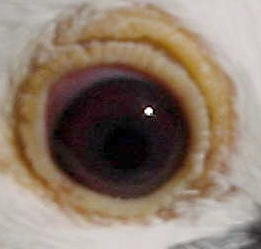
Bull
eye is similar in appearance to the dark eyes of most cattle;
that's where this bull eye color gets its name. Bull eyes are not a
substitute for either orange or pearl but rather only results when the
orange or pearl pigment has been turned off; thus allowing light to
pass thru the outer iris pigment, deeper into the eye and reflect the
darker pigment of the inner surface's of the eye. Genetically, a bull
eyed pigeon is still an orange or pearl eyed bird, however; the pigment
production (orange or pearl) on the outer surface of the iris has
simply been switched off by the pied white gene.
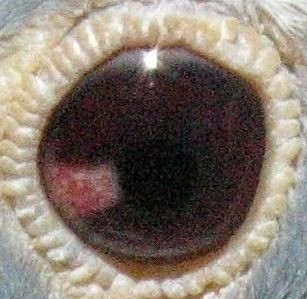

Photo by RK Pair
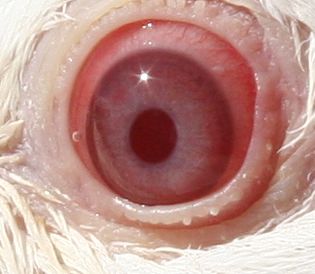
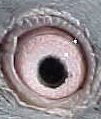
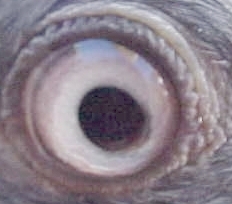

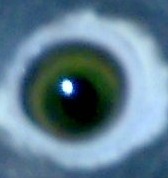
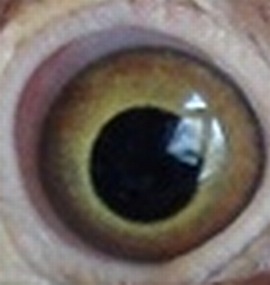
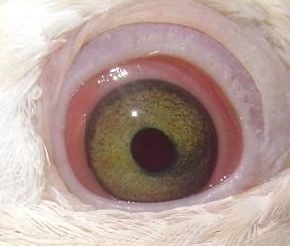
Richard Cryberg September
7, 2011 First
start with a general picture of the eye. The eye is basically
a ball
shaped structure. This ball has a hollow inside filled with a
liquid. On the back inside surface of the ball you find the
retina.
This is for practical purposes an extension of the brain. It
has a
considerable amount of data processing built right in the
eye. The
purpose of the retina is to detect light and color but the built in
image
processing in the eye throws away well over 90% of the data collected
and sends
the processed and compressed file to the brain.
What
follows are addational comments provided by Dr. Richard Cryberg.
Pigments
in Rock Dove Eyes
On
the outside surface around the pupil there is a colored area called
the
iris. The iris in pigeons ranges from a pink to greenish
(rare) or
blueish (rare) to orange to a whitish and any of these can have various
amounts
of blood vessels giving lots of tiny red lines. Pink is what
you get when
you have no pigments at all and just see blood vessels. The
rest of the
colors require pigments.
There
are a variety of pigments found in the eyes of different species
of
animals. Black and brown melanin pigments are quite
common. These
are the main pigments found in human irises. The rock dove
has two
pigments that are not often found in the iris. One is called
a guanidine
and the other is called a pteridine. That p on pteridine is
silent.
Guanidines are whitish platelet like pigments. They are very
common in
fish and give fish the silvery, shiny look These pigments are
quite
opaque and stop light from getting through the iris.
Pteridines are an
orange color. Both guanidines and pteridines seem to be
produced by
pigment cells in the iris that look remarkably like regular
melanocytes.
These pigment cells have dendrites just like melanocytes and sure look
like
another modified nerve cell. It is entirely possible, I
suppose, that
these cells are just melanocytes and have a different compliment of
genes
turned on so make different pigments than the melanocytes that pigment
feathers. Of course it is also possible that ice in feathers
is the
result of some guanidine production by melanocytes. So there
is more than
enough left to learn to keep us all happy with new ideas for a long
time to
come.
I
can not find publications that show that the front part of the pigeon
iris
has melanin in it. Still, I think that it is likely that
there is some
melanin in addition to the guanidine and pteridine. It is
hard to explain
the greens and blues and even hints of black seen in some
pigeon irises
if there is no melanin. And clearly lots and lots of animals
do make
brown and black melanin in the iris.
When
you have a normal bird with a mutation that shuts down production
of the
pteridine (orange) pigment in the iris you get a pearl eye.
In a pearl
eyed bird you just have guanidine and perhaps traces of melanin plus
the blood
vessels. We also know that a brown feathered bird has a false
pearl
eye. Presumably the chemical that is needed to turn brown
pigment into
black pigment is also needed for some important step in the manufacture
of
pteridine pigments. So a brown bird is unable to make
pteridines.
This would be further confirmation that those cells that make the eye
pigments
are not all that different, and perhaps not different at all other than
location, from the cells that pigment feathers. Also, albino
shuts off
both production of guanidines and pteridines. As albino is
simply a
mutation of the gene that codes for the enzyme tyrosinase it seems
clear that tyrosinase
must be important in production of both guanidines and
pteridines. This
again would confirm that these pigment cells are quite close to the
cells that
pigment feathers.
I should point out
that there is a significant difference in the iris of albino pigeons
from
various sources.
The Tumbler albino
seems to have the best vision according to what people report.
Tumbler
albinos are happy to nest at the top
of the loft while some other albinos hardly are willing to leave the
floor.
Looking at pictures there
do seem
to be some more or less white flat structures in the iris of Tumbler
albinos
that may help make the iris more opaque than other albinos.
It
is possible that these structures are some
type of guanidine and that not all albinos suppress guanidine
production
totally.
Or, they may be some
unknown
pigment type.
When
guanidine production is shut down in an albino the iris is no
longer
opaque. Some light is able to go right thru the iris to the
inner
eye. This is likely a lot of the reason for poor vision in
albinos.
Due to light entering the eye around the pupil it is not focused by the
lens
and there is a very poor image formed on the retina. An
albino of course
is also unable to make the black pigment in the inner front surface of
the eyeball.
I
am not aware of any mutations that shut down the guanidine production
and
leave pteridine production intact. I
sure would not say it would be impossible to have this happen.
Perhaps
we just have not recognized them?
Now,
let us cycle back to that black pigment on the inner front surface
of the
eye. In a recessive white or a pied bird with a white head
the eye is
called a bull eye. It is basically black all over.
The iris is a
bit different in color if you look real close but overall the
impression is a
black eye. Pieds are often caused by failure of the pigment
cells to
migrate, just under the skin, to their proper locations. Any
area that
ends up with no pigment cells has no pigment production
capability. If
that place is the outer surface of the iris there are no guanidines nor
pteridines produced. The net result is with no guanidines
which a great
reflectors and a bit like putting lots of tiny mirror fragments in the
iris you
can now see right thru the iris to the pigment on the inside surface of
the eye
which is black. So you get a bull eye.
The
obvious question is how does this black pigment get on the inner
front
surface of the eyeball if pigment cells failed to migrate?
Well, it turns
out that pigment cells have two migration routes. One route
is a surface
route and involves migration just under the skin layer. The
second
migration route is a core migration right thru the embryo's
body. This
core migration seems to get pigment cells to the brain, intestinal
tract, inner
eye and a variety of other internal places. There are even
mutations that
lead to black bones due to pigment cell migration into the
bones. I
surmise that the pigment cells that work on the inner surface of the
eyeball
must be core migrants while those that work on the outer surface of the
iris
are just under the skin migrants. Thus in a pied with a white
head the
just under the skin migration fails so no guanidine or pteridine
pigments are
in the iris.
Another
great question is why is a bull eye always black?
Suppose I took
a recessive red bird and added recessive white to it. Would
it not seem
reasonable for the pigment on the inner eye to be red pigment resulting
in
something like a reddish bull eye? Or the same game with a
brown bird
would lead to brown pigment in the inner surface? Well, I do
not
understand the details of the biochemistry at all. But
pigment produced
inside the body always seems to be black pigment. It is easy
enough to
avoid red by simply not allowing any free cysteine around during
pigment production.
And perhaps internally produced brown pigment is so dense it looks
black?
So there are lots of loose ends in this whole story that are
not well
understood. Or at least I have not stumbled across papers
that offer
explanations.
Ronald
R. Huntley
Copyright
1999 by Ronald Huntley.
Permission
is granted to download or copy
for
non-commercial individual use only.
The
author retains all other rights under copyright.
Web Page Designer
Duncan SC 29334
phone: (864) 249-0276